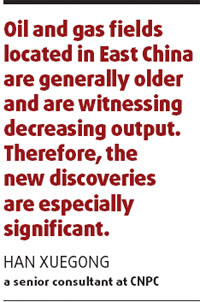Major oil reserves discovered in Bohai
By Lillian Liu and Wang Yu (China Daily)Updated: 2007-03-20 06:55
China's top oil producing and offshore oil companies simultaneously unveiled major discoveries on Monday.
PetroChina announced it had discovered a "very rich" oil field at Bohai Bay the biggest in China in the past decade while CNOOC said it has an "exciting find", also in Bohai Bay.
The PetroChina discovery, along with a new huge gas field the company discovered recently in Sichuan Province, will significantly improve the capacity of the country's biggest oil producer.
With an initial daily output of 500 tons (3,700 barrels), the Bohai Bay field is "the largest find in China in 10 years," Jiang Jiemin, vice-chairman and president of PetroChina, told a press conference in Hong Kong yesterday.
He did not elaborate on the total reserves of the Bohai oil field. The gas field in Sichuan has been tested to have a daily capacity of 1 million cubic meters.
"The two new fields are milestone discoveries. They have very steady output so far," said Jiang.
PetroChina has currently six domestic oil and gas fields with each one's
annual output breaking through 10 million tons of oil equivalent. 
Before that, China's largest fossil fuel find in the last 10 years was a 400-million-ton oil field in Northwest China by PetroChina.
Meanwhile, CNOOC announced yesterday that the Bohai Bay discovery involved a test output of 1,600 barrels of oil and approximately 10 million cubic feet of gas per day.
Zhu Weilin, vice-president of CNOOC, said of the "exciting" discovery: "We hope to develop a large-scale cluster of oil and gas fields (there) in the future."
The "encouraging" discoveries will substantially relieve China's energy thirst and increase prospects for energy independence, according to Han Xuegong, a senior consultant at CNPC, PetroChina's parent company.
"Major oil firms in China follow a consistent strategy priority for domestic oil and gas exploration and production. The new discoveries will support their strategy and solidify their business base on local oil and gas fields," Han said.
As production output at existing oil fields decreases by the year, the oil companies consistently need to explore new fields to keep the country's overall output stable.
"Oil and gas fields located in East China are generally older and are witnessing decreasing output. Therefore, the new discoveries are especially significant," Han pointed out.
China's strong demand for energy spurred PetroChina to produce an aggregate of over 1 billion barrels of oil equivalent last year with crude oil accounting for 831 million barrels.
Jiang forecast that PetroChina's oil output may rise to 2.3 million barrels a day this year, with gas production reaching 4.56 billion cubic feet a day. Its refineries will process an estimated 2.25 million barrels of crude daily.
The company recorded net income of 142.2 billion yuan ($18.34 billion) in 2006, compared to 133.4 billion yuan ($17.23 billion) a year earlier. The company posted a turnover of 689 billion yuan ($89 billion) last year, a year-on-year increase of 24.8 percent.
Capital spending would increase 25 percent this year as PetroChina is forced to drill deeper and further afield for oil and gas and as it expands refineries.
Last year, higher drilling costs and wider losses at the refineries hit the firm, which posted a 13 percent drop in second-half profit.
(China Daily 03/20/2007 page1)
|
||
|
||
|
|